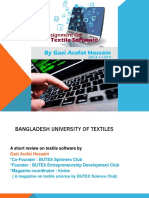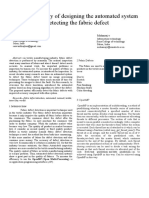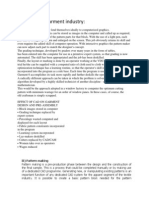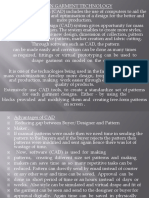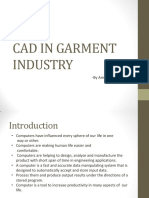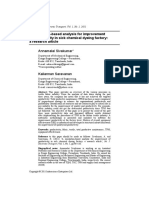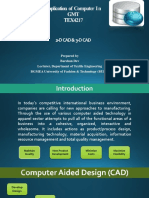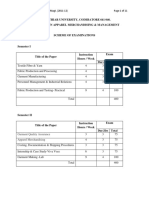Computerization in textile industry:
Computerized operation system has been an integral part in recent years in textile industries.
On the virtue of its data processing, display, portability, maintenance, reliability, computer,
microcomputer, microelectronics. The most important advantages are printed out here-
In Spinning Section
― The most important contribution is cared out by the CIM system which assures long storage
& collection of data, quality control, order supervision, material management & graphical
representation. E.g.USTER MILL DATA
― Bale management system has eliminated manual mixing, removing faults and ensuring
better production
― Automatic extraction of fiber and interactive blending UNIFLOC AI/L
― Autolevelling, removing of irregularity, reduction of silver breakage, speed control & display
of all important parameters in carding & drawing m/cs.
― Monitoring of all machine functions and rapid reaction in the event of faults, emergency
stops.
― Online monitoring of quality due to high material throughput and to enable high efficiency
― Collection of operation data & produced statistics for service personnel, production manager.
― Input of m/c data & process parameter.
― High functional reliability , simple & speedy elimination of faults, low cost design & high
productivity in Rotor spinning , introduction ROTOR DATA, ZAG, PEYER System.
― Reduced end breakage rate, improved efficiency in ring frame by RING DATA.
In Weaving Section
― The best computerization development in weaving section is the creation of an integrated of
an integrated like between the creative and analytical aspects and actual control of the loom.
― Easy pegging plan & efficient dobby mechanism
― Computer aided design in jacquard loom allowing frequent pattern change elimination
design error increasing flexibility.
― Diversification in the design of woven fabric.
― Direct loom control as in SULZER RUTI loom.
― Display of all required value like weft insertion rate, loom speed, thread breakage rate,
stoppage time etc.
�― Improvement in yarn cleaning, fault dictation, length measuring unit, piecing as in
CONEDATA system.
― Closing of socks & trimming automation.
― Computerised patterning & control in knitting machines.
In Dyeing Section
― Computerized color matching system provides optimum & economic colorant concentration
necessary for matching.
― Data color system provides the measurement of required shade % and determination of
color shade of a sample.
― BEACON controller provides uniform dyeing condition.
― Process data link chemical concentration, speed, temperature, shad % can be monitored &
displayed from different computer system.
― Improved efficiency of discontinuous dyeing process.
In Garment Section
― Computerized interactive marker making by CAD system.
― Very accurate, efficient cutting & spreading of fabric.
― Different automatic like auto trimming, speed control, auto thread cutting mechanism of
sewing machinery.
― Auto display of process data of the sewing m/c like model DDL 5550 JUKI.
― Introduction of CPD__ Computerized pattern design system.
― CED & CEM_ Computerized embroidery design and manufacturing system.
― Reduction in labor cost & high production from different stage of manufacturing.
In Testing Section
― For fibre testing →Lab data
― For fibre length measurement → Uster Fibrograph 730
― For cotton color & grade→Uster colorimeter 750
― For measuring micronaire of cotton → Micronaire 775
― For measuring florescent variation → Uster Fibroglow 380
― For measuring strength & elongation → Uster Stelometer 654
― For sampling of specimen → Fibrosample 192
― For measuring fibre end alignment & length → Uster AL 100
�― For measuring fibre fineness → Uster OFDA 100
― For filament testing → Uster Tester 3-C
― For measuring breaking load & breaking elongation Uster Tensotapid 3
In Textile Management Section
At each stage of production in textiles like order-listing, purchase and inventors, integrated
operation system, production planning, pay roll of labors, pay roll of report, export
documentation, research, investigation, computerized word process & database software play
important role.
Ref books:
Computer technology for textiles and apparel
-Edited by J Hu, Hong Kong Polytechnic University, Hong Kong
Woodhead Publishing Series in Textiles No. 121
Soft computing in textile engineering
-Edited by A Majumdar, Indian Institute of Technology, India
Woodhead Publishing Series in Textiles No. 111
Electronics & computing in textiles
-Savvas Vasiliadis













